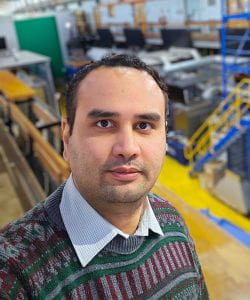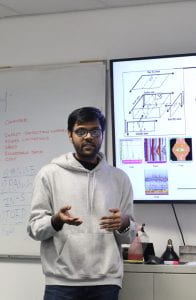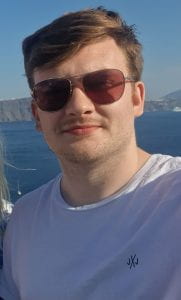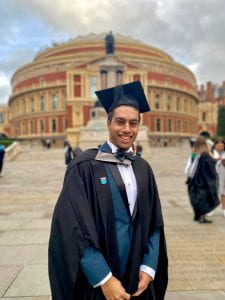Cohort 5
Elias Rabbat
University: Imperial
Supervisor: Dr Peter Huthwaite
PhD Project: Improved Ultrasonic Imaging for NDE
Traditionally, ultrasonic imaging in Non-Destructive Evaluation (NDE) has relied on rudimentary assumptions about wave propagation which greatly simplify the problem and enable images to be generated quickly. However, these assumptions often limit our capability for reliably
extracting all the information available.
This project aims to develop
new methods to incorporate more advanced physical models into the
imaging process, for improved resolution and accuracy. This could include Full Waveform Inversion (FWI) methods as well as Machine Learning (ML) techniques.
Yifei Yang
University: Imperial
Supervisors: Dr Bo Lan and Dr Frederic Cegla
PhD Project: NDE of Li-ion Battery Manufacturing
Currently, battery manufacturing processes are not a closed-loop process. There is no real-time product evaluation and feedback mechanism for manufacturing configuration optimisation, which could lead to a high level of wastage. This has illustrated urgent demands for NDE development.
My project focuses on the coating, drying, and calendaring processes of the battery electrodes and aims to build an inline characterisation tool which could be implemented to provide instant feedback on quality verification during electrode manufacturing.
Arthur James Ford
 University: Nottingham
University: Nottingham
Supervisors: Prof Rikesh Patel, Prof Richard Smith and Prof Matt Clark
PhD Project: Next-Gen Laser Ultrasound Instrument for Elasticity and Microstructure Analysis of Aerospace Alloys
This project aims to develop the next generation of a laser ultrasound instrument to simultaneously measure the single-crystal elasticity matrix, the microstructure and the crystallographic orientation of high-value aerospace alloys. Measuring a material’s elastic constants would be a ground-breaking development in materials science. In advanced manufacturing, measuring the elasticity matrix will allow control and optimisation of the mechanical properties, where it may be sought as a proxy for hard-to-measure crystallographic properties. The impact will also be felt in non-destructive evaluation, where, for the first time, high-fidelity materials data, usually the domain of laboratory-bound electron microscopes, could be available to measure on in-service components.
Oliver Coates
 University: Strathclyde
University: Strathclyde
Supervisor: Dr Katherine M. Tant, Prof Charles N. Macleod
Sponsor: Rolls Royce
EngD Project: Improving Ultrasonic Imaging Using Machine Learning
Ultrasonic inspection is a critical process in manufacturing. However, dealing with challenging
materials, such as anisotropic materials, can prove to be difficult. My project looks to explore
using machine learning methods as a potential solution to problems related to this by improving
the imaging of difficult materials and contributing to advancements within Non-Destructive
Testing (NDT).
Additionally, my project also focuses around trying to improve the machine learning process
itself – coming up with solutions that could aid in the timeliness of models & addressing issues
related to data unavailability, providing more efficient applications of machine learning within
NDT.
Sashank Chandramouli
 University: Strathclyde
University: Strathclyde
Supervisors: Prof Charles N Macleod and Dr Katherine Tant
PhD Project: In-Process Ultrasonic Inspection of Welds and Additively Manufactured Components with Complex Geometries
This PhD project seeks to improve the ultrasonic imaging of challenging components directly at the point of manufacture. Specifically targeting complex welds and wire arc additively manufactured components, this project seeks to extend and adapt thermal and microstructural compensation methods to optimise ultrasonic imaging.
This PhD work will focus on incorporating advanced PAUT imaging techniques for imaging in-process defects in complex shaped welds and WAAM components, thereby improving flexibility, accuracy, and speed of in-process robotic inspection.
Liuyu Chang
 University: Bristol
University: Bristol
Supervisors: Dr Jie Zhang and Prof Bruce Drinkwater
PhD Project: In-Situ Health Monitoring of Hydrogen Storage Containers and Pipelines Using Permanently Installed Ultrasonic Arrays
By developing a permanently installed ultrasonic array system to detect and characterize damages, the project aims to enhance the structural integrity assessment of hydrogen storage and pipelines. This has far-reaching implications for the sustainability of hydrogen-related industries including manufacturing, power generation, and transportation. The project will be achieved by integrating of the developed low-cost ultrasonic arrays with the inverse modelling methods to interpret historical stored ultrasonic array data.
Daniel Conniffe
 University: Manchester
University: Manchester
Supervisors: Prof Anthony Peyton and Dr Jim Skelton
Sponsor: Jacobs
EngD Project: Feasibility for Augmented Reality in Non-Destructive Testing
Virtual, augmented, and mixed reality, together known as XR, is an exciting and rapidly expanding area of technology with the potential to greatly enhance user capabilities. The purpose of this project is to investigate the practical application of XR in the context of NDE. Current inspection methods generate complex results that require extensive experience to interpret correctly. In addition, accurate and detailed documentation must be maintained to share and analyse results between parties.
XR has the potential to enhance the process by combining the digital and physical worlds, providing accurate positioning information as a matter of routine, and overlaying inspection data directly onto the target area or within the user’s field of view. Combining data with automated position tracking should lead to more widespread use of machine learning for interpretation and analysis. Furthermore, real-time sharing of results between parties will improve inspection efficiency and reduce potential for error.
Yuyang Liu
 University: Bristol
University: Bristol
Supervisors: Prof Anthony Croxford and Prof Paul Wilcox
PhD Project: Explainable Deep Learning for Corrosion Profiling in NDE
Recent AI and deep learning innovations are revolutionizing how NDE engineers interpret ultrasonic data for ultrasonic corrosion profiling. Current models are often accurate, but their “black box” nature obscures their reasoning in decision making, leaving doubts about their trustworthiness for industrial use. As the model may be mis-measuring some bias existing in the inputs rather than physical parameters. On the other hand, conventional interpret methods cannot be applied directly onto models trained for ultrasonic timeseries measurements without data fusion and model specified tuning. Therefore, the aims of my project include: 1) the development of deep learning based Explainable AI (XAI) in corrosion profiling and other NDE data analysis; 2) investigating deep learning models’ interpretation of ultrasonic timeseries measurements and other ultrasonic datasets; 3) the innovation of techniques for interpreting the decision-making logic of deep learning models applied in NDE.
Congcong Wang
University: Manchester
Supervisor: Prof Anthony Peyton
PhD Project: Advanced Inspection for Techniques for Graphite Core Reactors
Ines Carotti
University: Warwick
Supervisors: Prof James Covington, Dr Duncan Billson and Prof David Hutchins
PhD Project: Non-Invasive Detection of Corrosion Through Odour Emissions: Sniffing Out Rust
Martin Todd
University: Nottingham
Supervisor: Prof Rikesh Patel
PhD Project: Spatially Resolved Acoustic Spectroscopy as a Tool for Improving Additive Manufacturing Techniques
Ka Ho Chiu
University: Bristol
Supervisors: Dr Jie Zhang and Prof Bruce Drinkwater
PhD Project: Development of Low-Cost Robot Systems Integrated with Sensors for Pipe Inspection
Sam Serjeant
University: Strathclyde
Supervisor: Prof Charles Macleod
Sponsor: Sellafield
EngD Project: Improving Nuclear Weld Inspection
Yihang Jiang
University: Bristol
Supervisors: Dr Jie Zhang and Prof Paul Wilcox
PhD Project: Quality Control of Fabricating Additively Manufactured Components Using Ultrasound
Fangyuan Wan
University: Bristol
Supervisors: Dr Jie Zhang and Prof Tony Mulholland
PhD Project: Monitoring of Material Evolution During its Manufacturing Process and In-Service Using Ultrasound
Nalin Kamath
University: Bristol
Supervisor: Prof Anthony Croxford
PhD Project: Embedded Wireless Sensor Devices for Monitoring Composite Components
Yongxing Cai
University: Bristol
Supervisor: Jie Zhang and Tony Mulholland
PhD Project: Ultrasonic array inspection of surface breaking defects resided on corroded and uneven surfaces

